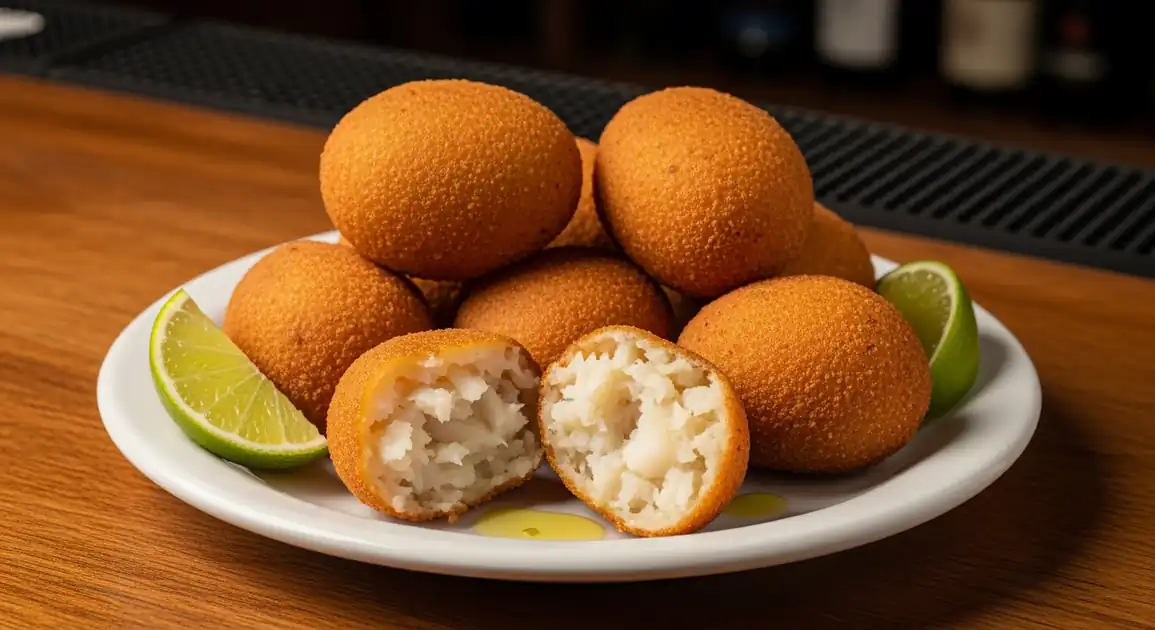Bolinho de Bacalhau (Salt Cod Fritter)
Bolinho de Bacalhau

Description
São Paulo, with its massive Portuguese community and vibrant food scene, offers countless excellent options for Bolinho de Bacalhau. From traditional Portuguese restaurants in Bela Vista/Bixiga to neighborhood 'botecos' across the city, high standards are common.
Dietary Information
Serving information
Serving style
Served hot, with lime wedges, olive oil readily available. Portions ('porção') are standard in bars.
Quick facts
Bars: Often 11 AM - 1 AM or later. Restaurants: 12 PM - 3 PM, 7 PM - 12 AM. Mercado Municipal: Daytime hours, closed evenings.
Safety Tips
What to Look For
-
Fried fresh to order ('Frito na Hora')
Ensures the bolinho is piping hot, crispy, and hasn't been sitting at unsafe temperatures. This minimizes risks and maximizes taste.
-
Served piping hot
Heat is a key safety factor in fried foods. The inside should be steaming.
-
Clean frying station and vendor hygiene
Look for clean oil, utensils, and proper food handling practices by the staff.
-
Crispy, golden-brown exterior
Indicates proper frying temperature and technique. Avoid soggy or burnt bolinhos.
-
Reputable bar or restaurant ('Boteco de Confiança')
Established places with good local reputation are generally safer bets for quality and hygiene.
What to avoid
-
Pre-fried bolinhos sitting under heat lamps or at room temperature
These can harbor bacteria and will lose their optimal texture. Insist on freshly fried.
-
Bolinhos that are lukewarm or cold
Indicates improper holding temperature, a significant food safety risk.
-
Excessively dark or dirty frying oil
Old oil can impart bad flavors and potentially contain harmful compounds.
-
Soggy or overly greasy appearance
May indicate oil temperature was too low (absorbing excess oil) or the bolinho is old.
-
Strong 'off' fishy smell
While cod has a distinct smell, a pungent, unpleasant fishy odor could indicate the bacalhau wasn't fresh or properly prepared.
Price information
Price range
Budget tips
- Neighborhood 'botecos' outside the main commercial centers (like Itaim Bibi, Jardins) offer better prices.
- Mercado Municipal might have stalls, but can be tourist-priced.
- Look for happy hour deals ('promoção de happy hour').
Value indicators
- Generous size or portion.
- High cod content (less potato filler).
- Perfectly crispy, not greasy.
- Made in-house ('produção própria').
Where to Find This Dish
Vila Madalena / Pinheiros
Known for its bustling bar scene, many 'botecos' here serve excellent bolinhos.
Rua Aspicuelta, Largo da Batata surroundings
Evening, Weekend Afternoons
Bela Vista / Bixiga
Historically Italian but with diverse offerings including traditional bars and some Portuguese influence.
Rua Augusta, Neighborhood cantinas and bars
Lunch, Dinner
Mercado Municipal de São Paulo
Famous market with food stalls, some offering Bolinhos de Bacalhau (check quality/price).
Mercadão
Daytime (market hours)
Mooca / Tatuapé (East Zone)
Traditional neighborhoods with established bars and restaurants often serving classic versions.
Local neighborhood bars
Evenings, Weekends
Vendor Tips
- Ask bartenders or waiters for their recommendation if unsure.
- Check reviews on local guides or apps for highly-rated bolinhos.
- Many traditional Portuguese bakeries ('padarias portuguesas') also make excellent ones.
How to Order
Regional Variations
-
High-End Restaurant Versions
(Versões de Restaurantes Sofisticados)
Some upscale restaurants might offer refined versions, potentially using premium cod or slightly different seasonings.
-
Bolinho 'do Mercadão'
(Bolinho 'do Mercadão')
While famous for Pastel de Bacalhau, some stalls in the Mercado Municipal also offer Bolinhos, known for generous fillings but potentially higher prices.
Cultural context
History
Salt cod ('bacalhau') is deeply ingrained in Portuguese cuisine due to historical maritime exploration and preservation methods. This culinary tradition was brought to Brazil during colonization. Bolinho de Bacalhau emerged as a popular way to utilize this prized ingredient, adapting Portuguese recipes to the Brazilian palate. It has since become a ubiquitous and cherished part of Brazil's gastronomic culture, especially within the social context of 'botecos'.
Local significance
A beloved staple in São Paulo's diverse culinary landscape, connecting the city to its Portuguese roots while being fully integrated into the local 'boteco' culture.
Eating customs
- Consumed alongside 'chope' (draft beer) or bottled beer.
- Often ordered as one of several 'petiscos' to share.